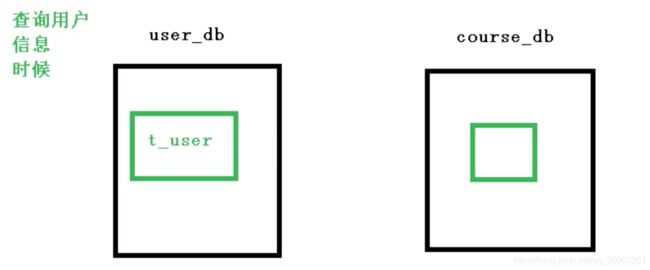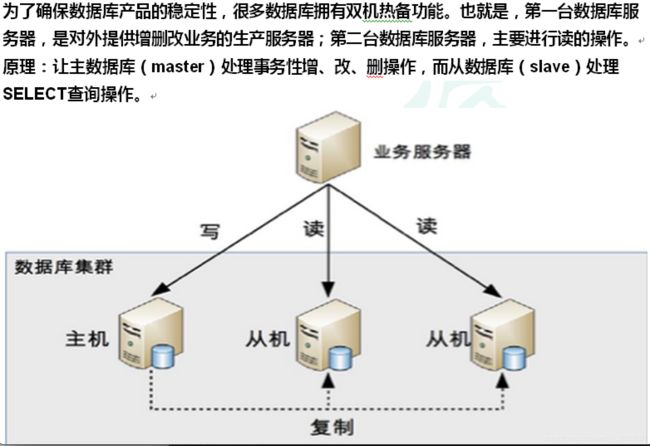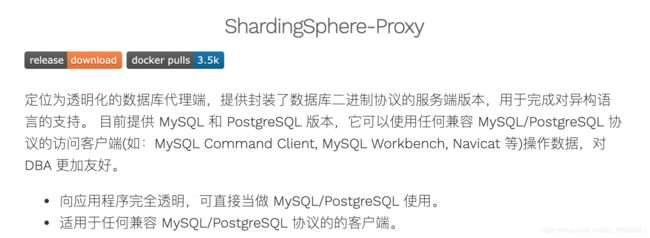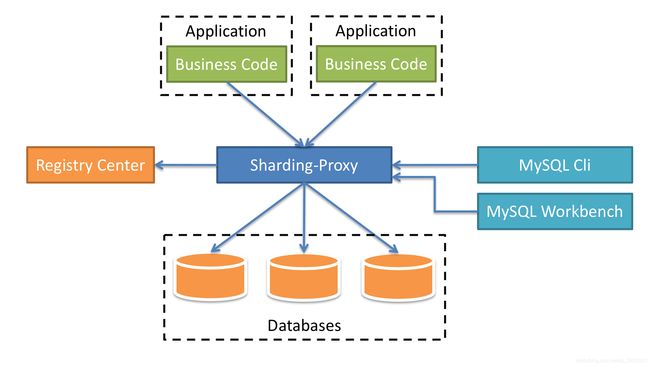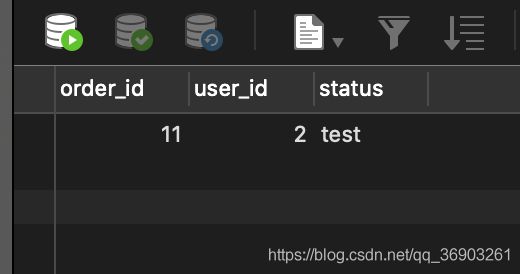一款比MyCat更强的分库分表利器:Sharding-Sphere
文章目录
- 一、基本概念
-
- Sharding-Sphere简介
- 分库分表
-
- 分库分表的方式
-
- 垂直分表
- 垂直分库
- 水平分库
- 水平分表
- 分库分表的应用和问题
- 二、Sharding-JDBC 分库分表操作
-
- ShardingSphere-JDBC 简介
- Sharding-JDBC 实现水平分表
-
- 搭建环境
- 按照水平分表的方式创建数据库、数据表
- 编写代码实现对分库分表数据的操作
- 配置水平分表策略
- 编写测试代码
- Sharding-JDBC 实现水平分库
-
- 需求分析
- 创建数据库,数据表
- 配置水平分库策略
- 编写测试代码
- Sharding-JDBC 实现垂直分库
-
- 需求分析
- 创建用户数据库、数据表
- 编写User代码
- 配置垂直分库策略
- 编写测试代码
- Sharding-JDBC 公共表
-
- 公共表概念
- 在多个数据库中创建相同结构的公共表
- 公共表配置
- 编写公共表的实体类及mapper
- 编写测试代码
- Sharding-JDBC 实现读写分离
-
- 读写分离概念
- 读写原理
- Sharding-JDBC 读写分离
- MySQL 一主一从读写分离配置
-
- Sharding-JDBC 操作
-
- 配置读写分离策略
- 三、Sharding-Proxy 分库分表操作
-
-
- ShardingSphere-Proxy 简介
- 下载安装 Sharding-Proxy
- 配置 Sharding-Proxy(分库配置)
- 配置 Sharding-Proxy(读写分离)
-
- mysql主从复制配置
- 创建数据库
- Sharding-Proxy 配置
- 测试
-
一、基本概念
Sharding-Sphere简介
Sharding-Sphere官网:http://shardingsphere.apache.org/index_zh.html
- 一套开源的分布式数据库中间件解决方案。
- 有三个产品,Sharding-JDBC、Sharding-Proxy 和 Sharding-Sidecar。
- ShardingSphere 定位为关系型数据库中间件,合理地在分布式环境下使用关系型数据库操作。
分库分表
数据据库数据量是不可控的,随着时间和业务发展,造成表里面数据越来越多,如果再去对数据库表curd操作时,就会有性能问题。
解决办法:
- 方案1:从硬件上
- 方案2:分库分表
分库分表的方式
分库分表有两种方式:垂直切分和水平切分。
- 垂直切分:垂直分表和垂直分库
- 水平切分:水平分表和水平分库
垂直拆字段,水平拆记录。
垂直切分的库和表结构是不同的,而水平切分的库和表是相同的。
垂直分表
操作数据库中某张表,把这张表中一部分字段数据存到一张新表里面,再把这张表另部分字段数据存到另外一张表里面。
垂直拆分成的两张表,每张表的数据量和原先的表的数据量相同。


垂直分库
水平分库
水平分表
分库分表的应用和问题
- 应用
- 在数据库设计时候就要考虑垂直分库和垂直分表。
- 随着数据库数据量增加,不要马上考虑做水平切分。首先考虑缓存处理,读写分离,使用索引等等方式。如果这些方式不能根本解决问题了,再考虑做水平分库和水平分表。
- 分库分表问题
- 跨节点连接查询问题(分页、排序)。
- 多数据源管理问题。
二、Sharding-JDBC 分库分表操作
ShardingSphere-JDBC 简介

Sharding-JDBC是轻量级的Java框架,是增强的JDBC驱动。
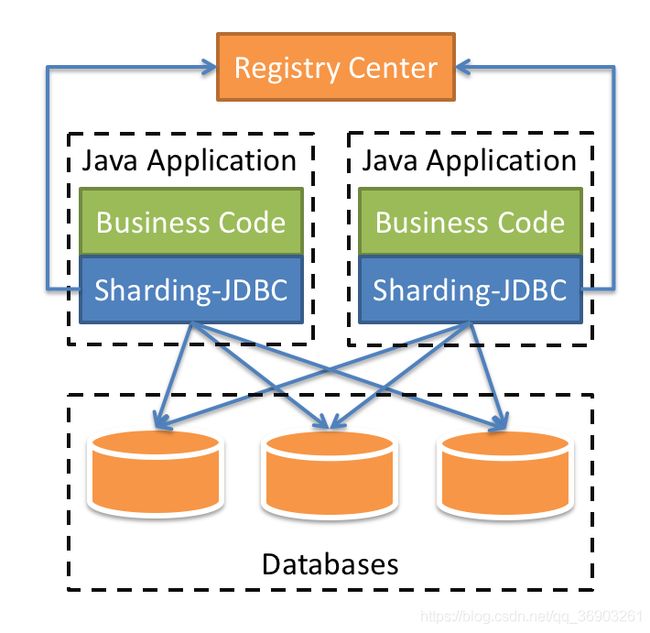
Sharding-JDBC的功能:主要做数据分片和读写分离,不是做分库分表,分库分表由我们自己做。
主要的目的:简化分库分表后数据的相关操作。
Sharding-JDBC 实现水平分表
搭建环境
技术:SpringBoot2.2.1 + MybatisPlus + Sharding-JDBC + Druid连接池
- 创建项目

- 修改SpringBoot的版本

- pom.xml引入相关的依赖
<dependency> <groupId>com.alibabagroupId> <artifactId>druid-spring-boot-starterartifactId> <version>1.1.20version> dependency> <dependency> <groupId>mysqlgroupId> <artifactId>mysql-connector-javaartifactId> <version>8.0.18version> dependency> <dependency> <groupId>org.apache.shardingspheregroupId> <artifactId>sharding-jdbc-spring-boot-starterartifactId> <version>4.0.0-RC1version> dependency> <dependency> <groupId>com.baomidougroupId> <artifactId>mybatis-plus-boot-starterartifactId> <version>3.0.5version> dependency> <dependency> <groupId>org.projectlombokgroupId> <artifactId>lombokartifactId> dependency>
按照水平分表的方式创建数据库、数据表
- 创建数据库 course_db。
- 在数据库中创建两张表 course_1 和 course_2。
- 数据存放约定规则:添加的数据id为偶数放 course_1 表中,id为奇数放 course_2 表中。
create database course_db;
use course_db;
create table course_1 (
`cid` bigint(20) primary key,
`cname` varchar(50) not null,
`user_id` bigint(20) not null,
`cstatus` varchar(10) not null
);
create table course_2 (
`cid` bigint(20) primary key,
`cname` varchar(50) not null,
`user_id` bigint(20) not null,
`cstatus` varchar(10) not null
);
编写代码实现对分库分表数据的操作
- 在shardingjdbcdemo包下创建 entity.Course 实体类
@Data public class Course { private Long cid; private String cname; private Long userId; private String cstatus; } - 创建mapper.CourseMapper 接口
@Repository public interface CourseMapper extends BaseMapper<Course> {} - 在启动类上加上
@MapperScan("com.angenin.shardingjdbcdemo.mapper")注解
配置水平分表策略
官网数据分片配置:https://shardingsphere.apache.org/document/current/cn/user-manual/shardingsphere-jdbc/usage/sharding/spring-boot-starter/

在 application.properties 配置文件中配置:(下面数据库密码记得写)
# shardingjdbc 水平分表策略
# 配置数据源,给数据源起别名
spring.shardingsphere.datasource.names=m1
# 一个实体类对应两张表,覆盖
spring.main.allow-bean-definition-overriding=true
# 配置数据源的具体内容,包含连接池,驱动,地址,用户名,密码
spring.shardingsphere.datasource.m1.type=com.alibaba.druid.pool.DruidDataSource
spring.shardingsphere.datasource.m1.driver-class-name=com.mysql.cj.jdbc.Driver
spring.shardingsphere.datasource.m1.url=jdbc:mysql://localhost:3306/course_db?serverTimezone=GMT%2B8
spring.shardingsphere.datasource.m1.username=root
spring.shardingsphere.datasource.m1.password=
# 指定course表分布的情况,配置表在哪个数据库里,表的名称都是什么 m1.course_1,m1.course_2
spring.shardingsphere.sharding.tables.course.actual-data-nodes=m1.course_$->{1..2}
# 指定 course 表里面主键 cid 的生成策略 SNOWFLAKE
spring.shardingsphere.sharding.tables.course.key-generator.column=cid
spring.shardingsphere.sharding.tables.course.key-generator.type=SNOWFLAKE
# 配置分表策略 约定 cid 值偶数添加到 course_1 表,如果 cid 是奇数添加到 course_2 表
spring.shardingsphere.sharding.tables.course.table-strategy.inline.shardingcolumn=cid
spring.shardingsphere.sharding.tables.course.table-strategy.inline.algorithmexpression=course_$->{cid % 2 + 1}
# 打开 sql 输出日志
spring.shardingsphere.props.sql.show=true
编写测试代码
在test包中的测试类中进行测试
@RunWith(SpringRunner.class)
@SpringBootTest
public class ShardingjdbcdemoApplicationTests {
@Autowired
private CourseMapper courseMapper;
//添加课程
@Test
public void addCourse(){
Course course = new Course();
//cid由我们设置的策略,雪花算法进行生成(至少70年内生成的id不会重复)
course.setCname("java");
course.setUserId(100L);
course.setCstatus("Normal");
courseMapper.insert(course);
}
//查询课程
@Test
public void findCourse(){
QueryWrapper<Course> wrapper = new QueryWrapper<>();
wrapper.eq("cid", 509755853058867201L);
courseMapper.selectOne(wrapper);
}
}
addCourse方法执行结果:


findCourse方法执行结果:

Sharding-JDBC 实现水平分库
需求分析
创建数据库,数据表
create database edu_db_1;
create database edu_db_2;
use edu_db_1;
create table course_1 (
`cid` bigint(20) primary key,
`cname` varchar(50) not null,
`user_id` bigint(20) not null,
`cstatus` varchar(10) not null
);
create table course_2 (
`cid` bigint(20) primary key,
`cname` varchar(50) not null,
`user_id` bigint(20) not null,
`cstatus` varchar(10) not null
);
use edu_db_2;
create table course_1 (
`cid` bigint(20) primary key,
`cname` varchar(50) not null,
`user_id` bigint(20) not null,
`cstatus` varchar(10) not null
);
create table course_2 (
`cid` bigint(20) primary key,
`cname` varchar(50) not null,
`user_id` bigint(20) not null,
`cstatus` varchar(10) not null
);
配置水平分库策略
下面数据库的密码填自己的。
# shardingjdbc 水平分库分表策略
# 配置数据源,给数据源起别名
# 水平分库需要配置多个数据库
spring.shardingsphere.datasource.names=m1,m2
# 一个实体类对应两张表,覆盖
spring.main.allow-bean-definition-overriding=true
# 配置第一个数据源的具体内容,包含连接池,驱动,地址,用户名,密码
spring.shardingsphere.datasource.m1.type=com.alibaba.druid.pool.DruidDataSource
spring.shardingsphere.datasource.m1.driver-class-name=com.mysql.cj.jdbc.Driver
spring.shardingsphere.datasource.m1.url=jdbc:mysql://localhost:3306/edu_db_1?serverTimezone=GMT%2B8
spring.shardingsphere.datasource.m1.username=root
spring.shardingsphere.datasource.m1.password=
# 配置第二个数据源的具体内容,包含连接池,驱动,地址,用户名,密码
spring.shardingsphere.datasource.m2.type=com.alibaba.druid.pool.DruidDataSource
spring.shardingsphere.datasource.m2.driver-class-name=com.mysql.cj.jdbc.Driver
spring.shardingsphere.datasource.m2.url=jdbc:mysql://localhost:3306/edu_db_2?serverTimezone=GMT%2B8
spring.shardingsphere.datasource.m2.username=root
spring.shardingsphere.datasource.m2.password=
# 指定数据库分布的情况和数据表分布的情况
# m1 m2 course_1 course_2
spring.shardingsphere.sharding.tables.course.actual-data-nodes=m$->{1..2}.course_$->{1..2}
# 指定 course 表里面主键 cid 的生成策略 SNOWFLAKE
spring.shardingsphere.sharding.tables.course.key-generator.column=cid
spring.shardingsphere.sharding.tables.course.key-generator.type=SNOWFLAKE
# 指定分库策略 约定 user_id 值偶数添加到 m1 库,如果 user_id 是奇数添加到 m2 库
# 默认写法(所有的表的user_id)
#spring.shardingsphere.sharding.default-database-strategy.inline.sharding-column=user_id
#spring.shardingsphere.sharding.default-database-strategy.inline.algorithm-expression=m$->{user_id % 2 + 1}
# 指定只有course表的user_id
spring.shardingsphere.sharding.tables.course.database-strategy.inline.sharding-column=user_id
spring.shardingsphere.sharding.tables.course.database-strategy.inline.algorithm-expression=m$->{user_id % 2 + 1}
# 指定分表策略 约定 cid 值偶数添加到 course_1 表,如果 cid 是奇数添加到 course_2 表
spring.shardingsphere.sharding.tables.course.table-strategy.inline.sharding-column=cid
spring.shardingsphere.sharding.tables.course.table-strategy.inline.algorithm-expression=course_$->{cid % 2 + 1}
# 打开 sql 输出日志
spring.shardingsphere.props.sql.show=true
编写测试代码
//添加课程
@Test
public void addCourseDb(){
Course course = new Course();
//cid由我们设置的策略,雪花算法进行生成(至少70年内生成的id不会重复)
course.setCname("javademo");
//分库根据user_id
course.setUserId(100L);
course.setCstatus("Normal");
courseMapper.insert(course);
course.setCname("javademo2");
course.setUserId(111L);
courseMapper.insert(course);
}
//查询课程
@Test
public void findCourseDb(){
QueryWrapper<Course> wrapper = new QueryWrapper<>();
//设置user_id的值
wrapper.eq("user_id", 100L);
//设置cid的值
wrapper.eq("cid", 509771111076986881L);
Course course = courseMapper.selectOne(wrapper);
System.out.println(course);
}
addCourseDb方法执行结果:




findCourseDb方法执行结果:

Sharding-JDBC 实现垂直分库
需求分析
创建用户数据库、数据表
create database user_db;
use user_db;
create table t_user(
`user_id` bigint(20) primary key,
`username` varchar(100) not null,
`ustatus` varchar(50) not null
);
编写User代码
创建user实体类和对应的mapper
@Data
@TableName("t_user") //指定对应的表名
public class User {
private Long userId;
private String username;
private String ustatus;
}
@Repository
public interface UserMapper extends BaseMapper<User> {}
配置垂直分库策略
记得写数据库密码。
# shardingjdbc 垂直分库策略
# 配置数据源,给数据源起别名
# 水平分库需要配置多个数据库
# m0为用户数据库
spring.shardingsphere.datasource.names=m1,m2,m0
# 一个实体类对应两张表,覆盖
spring.main.allow-bean-definition-overriding=true
# 配置第一个数据源的具体内容,包含连接池,驱动,地址,用户名,密码
spring.shardingsphere.datasource.m1.type=com.alibaba.druid.pool.DruidDataSource
spring.shardingsphere.datasource.m1.driver-class-name=com.mysql.cj.jdbc.Driver
spring.shardingsphere.datasource.m1.url=jdbc:mysql://localhost:3306/edu_db_1?serverTimezone=GMT%2B8
spring.shardingsphere.datasource.m1.username=root
spring.shardingsphere.datasource.m1.password=
# 配置第二个数据源的具体内容,包含连接池,驱动,地址,用户名,密码
spring.shardingsphere.datasource.m2.type=com.alibaba.druid.pool.DruidDataSource
spring.shardingsphere.datasource.m2.driver-class-name=com.mysql.cj.jdbc.Driver
spring.shardingsphere.datasource.m2.url=jdbc:mysql://localhost:3306/edu_db_2?serverTimezone=GMT%2B8
spring.shardingsphere.datasource.m2.username=root
spring.shardingsphere.datasource.m2.password=
# 配置user数据源的具体内容,包含连接池,驱动,地址,用户名,密码
spring.shardingsphere.datasource.m0.type=com.alibaba.druid.pool.DruidDataSource
spring.shardingsphere.datasource.m0.driver-class-name=com.mysql.cj.jdbc.Driver
spring.shardingsphere.datasource.m0.url=jdbc:mysql://localhost:3306/user_db?serverTimezone=GMT%2B8
spring.shardingsphere.datasource.m0.username=root
spring.shardingsphere.datasource.m0.password=
# 配置user_db数据库里面t_user 专库专表
spring.shardingsphere.sharding.tables.t_user.actual-data-nodes=m0.t_user
# 配置主键的生成策略
spring.shardingsphere.sharding.tables.t_user.key-generator.column=user_id
spring.shardingsphere.sharding.tables.t_user.key-generator.type=SNOWFLAKE
# 指定分表策略
spring.shardingsphere.sharding.tables.t_user.table-strategy.inline.sharding-column=user_id
spring.shardingsphere.sharding.tables.t_user.table-strategy.inline.algorithm-expression=t_user
# ... 其他配置同上
编写测试代码
//添加用户
@Test
public void addUserDb(){
User user = new User();
user.setUsername("张三");
user.setUstatus("a");
userMapper.insert(user);
}
@Test
//查询用户
public void findUserDb(){
QueryWrapper<User> wrapper = new QueryWrapper<>();
wrapper.eq("user_id", 509793334663839745L);
User user = userMapper.selectOne(wrapper);
System.out.println(user);
}
addUserDb方法执行结果:


findUserDb方法执行结果:

Sharding-JDBC 公共表
公共表概念
- 存储固定数据的表,表数据很少发生变化,查询时经常要进行关联。
- 在每个数据库中都创建出相同结构公共表。
- 操作公共表时,同时操作添加了公共表的数据库中的公共表,添加记录时,同时添加,删除时,同时删除。
在多个数据库中创建相同结构的公共表
use user_db;
#use edu_db_1;
#use edu_db_2;
create table t_udict(
`dictid` bigint(20) primary key,
`ustatus` varchar(100) not null,
`uvalue` varchar(100) not null
);
公共表配置
# 其他配置同上
# ...
# 公共表配置
spring.shardingsphere.sharding.broadcast-tables=t_udict
# 配置主键的生成策略
spring.shardingsphere.sharding.tables.t_udict.key-generator.column=dictid
spring.shardingsphere.sharding.tables.t_udict.key-generator.type=SNOWFLAKE
# ...
编写公共表的实体类及mapper
@Data
@TableName(value = "t_udict")
public class Udict {
private Long dictid;
private String ustatus;
private String uvalue;
}
@Repository
public interface UdictMapper extends BaseMapper<Udict> {}
编写测试代码
//添加
@Test
public void addDict(){
Udict udict = new Udict();
udict.setUstatus("a");
udict.setUvalue("已启用");
udictMapper.insert(udict);
}
//删除
@Test
public void deleteDict(){
QueryWrapper<Udict> wrapper = new QueryWrapper<>();
wrapper.eq("dictid", 509811689974136833L);
udictMapper.delete(wrapper);
}
addDict方法执行结果:


deleteDict方法执行结果:


Sharding-JDBC 实现读写分离
读写分离概念
读写原理
Sharding-JDBC 读写分离

Sharding-JDBC通过sql语句语义分析,当sql语句有insert、update、delete时,Sharding-JDBC就把这次操作在主数据库上执行;当sql语句有select时,就会把这次操作在从数据库上执行,从而实现读写分离过程。但Sharding-JDBC并不会做数据同步,数据同步是配置MySQL后由MySQL自己完成的。
MySQL 一主一从读写分离配置
我采用的是docker来实现的,单独写在这篇文章里:https://blog.csdn.net/qq_36903261/article/details/108457759
使用docker后,需要在主服务器上新建原先的数据库数据表。
因为记录的文件名以及位点每次重启或刷新都会改变,所以以下命令放在这里,方便查看。
主mysql:
#确认位点 记录下文件名以及位点(重启或者刷新都会改变)
show master status;
从mysql:
#先停止同步
STOP SLAVE;
#修改从库指向到主库,使用上一步记录的文件名以及位点
# master_host docker容器linux的ip地址
# master_port 主mysql暴露的端口
# master_user 主mysql的用户名
# master_password 主mysql的密码
#(最后两项修改成刚刚从主mysql查到的,主mysql每次刷新权限或者重启时,这两个值都会改变,所以每次都需要查看是否相同)
CHANGE MASTER TO
master_host = '10.211.55.26',
master_port = 33060,
master_user = 'db_sync',
master_password = 'db_sync',
master_log_file = 'mysql-bin.000001',
master_log_pos = 823;
#启动同步
START SLAVE;
#查看Slave_IO_Runing和Slave_SQL_Runing字段值都为Yes,表示同步配置成功。
show slave status \G;
Sharding-JDBC 操作
配置读写分离策略
也使用docker的,复制的时候记得改一下ip地址
# 配置数据源,给数据源起别名
# m0为用户数据库
spring.shardingsphere.datasource.names=m0,s0
# 一个实体类对应两张表,覆盖
spring.main.allow-bean-definition-overriding=true
#user_db 主服务器
spring.shardingsphere.datasource.m0.type=com.alibaba.druid.pool.DruidDataSource
spring.shardingsphere.datasource.m0.driver-class-name=com.mysql.cj.jdbc.Driver
spring.shardingsphere.datasource.m0.url=jdbc:mysql://10.211.55.26:33060/user_db?serverTimezone=GMT%2B8
spring.shardingsphere.datasource.m0.username=root
spring.shardingsphere.datasource.m0.password=123456
#user_db 从服务器
spring.shardingsphere.datasource.s0.type=com.alibaba.druid.pool.DruidDataSource
spring.shardingsphere.datasource.s0.driver-class-name=com.mysql.cj.jdbc.Driver
spring.shardingsphere.datasource.s0.url=jdbc:mysql://10.211.55.26:33061/user_db?serverTimezone=GMT%2B8
spring.shardingsphere.datasource.s0.username=root
spring.shardingsphere.datasource.s0.password=123456
# 主库从库逻辑数据源定义 ds0 为 user_db
spring.shardingsphere.sharding.master-slave-rules.ds0.master-data-source-name=m0
spring.shardingsphere.sharding.master-slave-rules.ds0.slave-data-source-names=s0
# 配置user_db数据库里面t_user 专库专表
#spring.shardingsphere.sharding.tables.t_user.actual-data-nodes=m0.t_user
# t_user 分表策略,固定分配至 ds0 的 t_user 真实表
spring.shardingsphere.sharding.tables.t_user.actual-data-nodes=ds0.t_user
# 配置主键的生成策略
spring.shardingsphere.sharding.tables.t_user.key-generator.column=user_id
spring.shardingsphere.sharding.tables.t_user.key-generator.type=SNOWFLAKE
# 指定分表策略
spring.shardingsphere.sharding.tables.t_user.table-strategy.inline.sharding-column=user_id
spring.shardingsphere.sharding.tables.t_user.table-strategy.inline.algorithm-expression=t_user
# 打开 sql 输出日志
spring.shardingsphere.props.sql.show=true
测试代码使用垂直分库时编写的addUserDb和findUserDb方法。
addUserDb方法执行结果:


findUserDb方法执行结果:

三、Sharding-Proxy 分库分表操作
ShardingSphere-Proxy 简介
- ShardingSphere-Proxy定位为透明的数据库代理端。
- Sharding-Proxy独立应用,使用安装服务,进行分库分表或者读写分离配置、启动。
下载安装 Sharding-Proxy
https://shardingsphere.apache.org/document/current/cn/downloads/


下载解压后,需要把lib目录下后缀不全的jar包名补全。
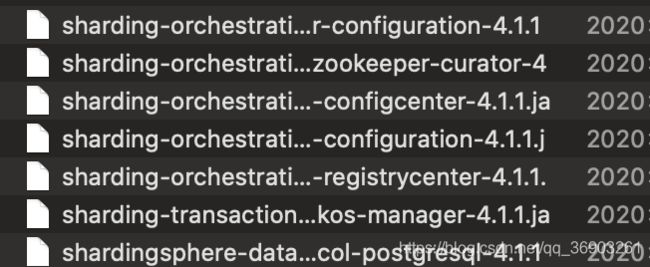
配置 Sharding-Proxy(分库配置)
进入conf目录
- 修改 server.yaml 文件(此文件为Sharding-Proxy的配置),去除掉authentication和props的注释。

- 修改 config-sharding.yaml 配置文件(此文件为分库分表的配置)

文件里提示说,如果使用mysql,需要把mysql的驱动jar包放到lib目录下。(到maven下载的jar包里找即可)
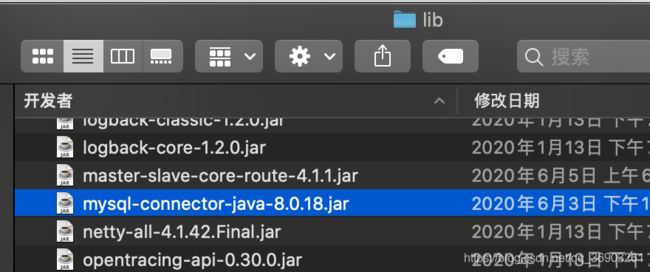
在主mysql上新建一个edu_1数据库(create database edu_1;)
然后去掉文件中关于mysql的配置代码的注释,然后进行修改。(这里我连的是docker上的主mysql)schemaName: sharding_db dataSources: ds_0: url: jdbc:mysql://10.211.55.26:33060/edu_1?serverTimezone=UTC&useSSL=false username: root password: 123456 connectionTimeoutMilliseconds: 30000 idleTimeoutMilliseconds: 60000 maxLifetimeMilliseconds: 1800000 maxPoolSize: 50 shardingRule: tables: t_order: actualDataNodes: ds_${0}.t_order_${0..1} tableStrategy: inline: shardingColumn: order_id algorithmExpression: t_order_${order_id % 2} keyGenerator: type: SNOWFLAKE column: order_id bindingTables: - t_order defaultDatabaseStrategy: inline: shardingColumn: user_id algorithmExpression: ds_${0} defaultTableStrategy: none: - 启动 Sharding-Proxy 服务
从终端进入到bin目录,然后./start.sh启动服务。(空格然后加上端口号,可以指定端口,默认3307)

如果打开logs目录里的stdout.log文件,显示下面这种,说明启动成功。

通过终端进行连接:
mysql -uroot -proot -P3307
如果出现下面这种错误,可以尝试连接命令加上-h127.0.0.1。

mysql -uroot -proot -h127.0.0.1 -P3307

- 新建一张表,并插入一条数据。
use sharding_db; create table if not exists ds_0.t_order(`order_id` bigint primary key,`user_id` int not null,`status` varchar(50)); insert into t_order(`order_id`,`user_id`,`status`)values(11,1,'test');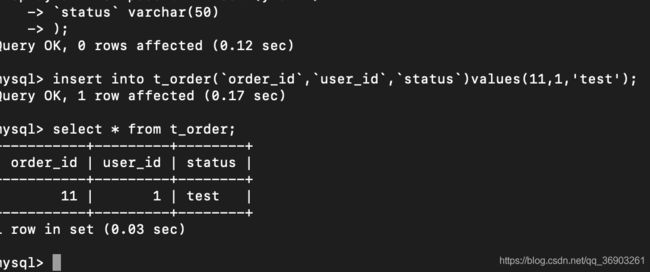
按照order_id进行分配,因为id是奇数所以被分到了t_order_1表里。

配置 Sharding-Proxy(读写分离)
Sharding-Proxy与Sharding-JDBC一样,并不会进行主从复制,主从复制依然是有MySQL自己完成。
mysql主从复制配置
把上面mysql主从复制的配置复制下来,方便查看:https://blog.csdn.net/qq_36903261/article/details/108457759
使用docker后,需要在主服务器上新建原先的数据库数据表。
因为记录的文件名以及位点每次重启或刷新都会改变,所以以下命令放在这里,方便查看。
主mysql:
#确认位点 记录下文件名以及位点(重启或者刷新都会改变)
show master status;
从mysql:
#先停止同步
STOP SLAVE;
#修改从库指向到主库,使用上一步记录的文件名以及位点
# master_host docker容器linux的ip地址
# master_port 主mysql暴露的端口
# master_user 主mysql的用户名
# master_password 主mysql的密码
#(最后两项修改成刚刚从主mysql查到的,主mysql每次刷新权限或者重启时,这两个值都会改变,所以每次都需要查看是否相同)
CHANGE MASTER TO
master_host = '10.211.55.26',
master_port = 33060,
master_user = 'db_sync',
master_password = 'db_sync',
master_log_file = 'mysql-bin.000001',
master_log_pos = 823;
#启动同步
START SLAVE;
#查看Slave_IO_Runing和Slave_SQL_Runing字段值都为Yes,表示同步配置成功。
show slave status \G;
创建数据库
老师这里只演示读写分离,并没有mysql的主从复制,我写的是主从复制,读写分离。
#主mysql
create database master_slave_order;
Sharding-Proxy 配置
修改 config-master_slave.yaml 文件(此文件为读写分离的配置)
schemaName: master_slave_db
dataSources:
master_ds:
url: jdbc:mysql://10.211.55.26:33060/master_slave_order?serverTimezone=UTC&useSSL=false&allowPublicKeyRetrieval=true
username: root
password: 123456
connectionTimeoutMilliseconds: 30000
idleTimeoutMilliseconds: 60000
maxLifetimeMilliseconds: 1800000
maxPoolSize: 50
slave_ds_0:
url: jdbc:mysql://10.211.55.26:33061/master_slave_order?serverTimezone=UTC&useSSL=false&allowPublicKeyRetrieval=true
username: root
password: 123456
connectionTimeoutMilliseconds: 30000
idleTimeoutMilliseconds: 60000
maxLifetimeMilliseconds: 1800000
maxPoolSize: 50
masterSlaveRule:
name: ms_ds
masterDataSourceName: master_ds
slaveDataSourceNames:
- slave_ds_0
# - slave_ds_1
测试
-
启动Sharding-Proxy 服务
./start.sh

-
创建数据表
use master_slave_db; create table if not exists master_slave_order.t_order(`order_id` bigint primary key,`user_id` int not null,`status` varchar(50)); insert into t_order(`order_id`,`user_id`,`status`)values(11,1,'test');
学习视频(p1-p23):https://www.bilibili.com/video/BV1LK411s7RX?p=1







